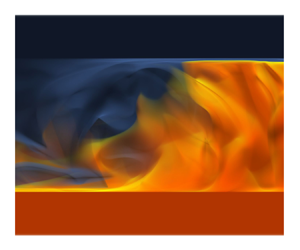Article contents
Realizing the ultimate scaling in convection turbulence by spatially decoupling the thermal and viscous boundary layers
Published online by Cambridge University Press: 25 May 2021
Abstract

Turbulent convection plays a crucial role in many natural environments and engineering applications. One of the most fundamental questions is how the heat flux depends on the thermal driving and fluid property. It has been proposed that when the fluid layer experiences extremely strong thermal driving, the boundary layers will become fully turbulent and the so-called ultimate regime will emerge. In this work we proposed a numerical experiment in which the thermal boundary layer can be spatially decoupled with the viscous one. We demonstrate that, once the thermal boundary layer is fully decoupled from the viscous boundary layer and locates entirely inside the turbulent bulk, the scaling laws corresponding to the ultimate regime can be obtained, namely  $Nu \sim Ra^{1/2}Pr^{1/2}$ and
$Nu \sim Ra^{1/2}Pr^{1/2}$ and  $Re \sim Ra^{1/2} Pr^{-1/2}$ with
$Re \sim Ra^{1/2} Pr^{-1/2}$ with  $Nu$ being the Nusselt number,
$Nu$ being the Nusselt number,  $Re$ the Reynolds number,
$Re$ the Reynolds number,  $Ra$ the Rayleigh number and
$Ra$ the Rayleigh number and  $Pr$ the Prandtl number, respectively. Therefore, our results support the physical conjecture of the ultimate regime for the turbulent convection.
$Pr$ the Prandtl number, respectively. Therefore, our results support the physical conjecture of the ultimate regime for the turbulent convection.
JFM classification
- Type
- JFM Rapids
- Information
- Copyright
- © The Author(s), 2021. Published by Cambridge University Press
References
REFERENCES
- 5
- Cited by





